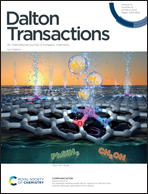Cation modulated spin state and near room temperature transition within a family of compounds containing the same [FeL2]2− center†
Abstract
Spin-crossover (SCO) active compounds have received much attention due to their potential application in molecular devices. Herein, a family of solvent-free FeII compounds, formulated as (A)2[FeL2], (H2L = pyridine-2,6-bi-tetrazolate, A = (Me)4N+1, Et2NH2+2, iPr2NH2+3 and iPrNH3+4), were synthesized and characterized. Single-crystal X-ray diffraction studies reveal that 1–4 are all supramolecular frameworks containing the same [FeL2]2− center, which is arranged into two packing modes via inter-molecular interactions, that is, a 3D architecture in 1 and 1D chain in 2–4. The spin states of 1–4 at different temperatures are assigned on the basis of the single-crystal X-ray diffraction data. Solid state magnetic investigations indicate that 1 and 4 exhibit a low spin state (below 350 K) and high spin state (2–400 K), respectively. 2 and 3 display clear SCO behavior in the measured temperature, but with different profiles and critical temperatures. 2 undergoes a complete gradual SCO with a critical temperature of T1/2 = 260 K. 3 has an abrupt near room temperature transition between T1/2 cooling = 278 K and T1/2 warming = 286, centered at 282 K (9 °C). This study reveals the importance of organic cations in the modulation of SCO behavior and offers a new insight for the design of SCO compounds with near room temperature spin transitions.
![Graphical abstract: Cation modulated spin state and near room temperature transition within a family of compounds containing the same [FeL2]2− center](/en/Image/Get?imageInfo.ImageType=GA&imageInfo.ImageIdentifier.ManuscriptID=D1DT04254H&imageInfo.ImageIdentifier.Year=2022)


 Please wait while we load your content...
Please wait while we load your content...